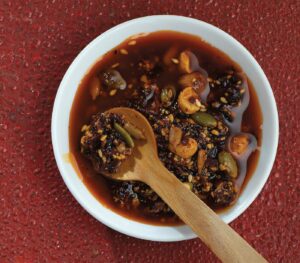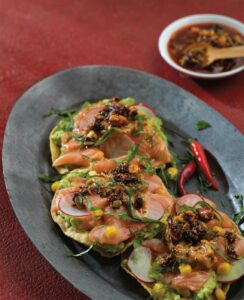
Exploring the links between Asia and the Americas
PHOTOGRAPHY BY PATRICK TREGENZA
Cuisines love dialogue. That is precisely how the fabric of our tablecloths is woven, through exchanges among people, navigating generations and continents. Discovering something new, and somehow making it our own, is how we build identities.
Therein lies the reason why defining authenticity can be tricky. Especially when you are staring at a grocery shelf where two apparent strangers with similar looks— Chinese chili oil and Mexican salsa macha—might be closer than a whole ocean apart.
For 250 years during Spanish colonial times, Mexico had a fascinating exchange with Asia. Spanish trading ships known as Manila galleons carried goods back and forth across the Pacific to the port of Acapulco, then merchandise traveled across Mexico and left for Europe from Veracruz, on the Gulf of Mexico. That’s how ingredients so ingrained in Mexican cuisine like limes, cilantro, tamarind, mango, and sesame were embraced, alongside techniques like ceviche. And Asian spices like clove, star anise and cinnamon were adopted in dishes like mole poblano. Ginger, although navigating on the same boat, never gained popularity.
The China ships also carried goods back to Asia, among them tomatoes, chocolate and the widely welcomed chiles. Chiles arrived in China around 1570 and were embraced at the table and for medical use. They were finely chopped and placed in oil to preserve them, and the rest is history.
There are as many versions of salsa macha as proud grandmothers claiming theirs as the original version.
Chili oil has become one of the most widely used condiments, as well as an ingredient in recipes. It can go from a bright red, light oil to a dark, dense paste. Oil is a perfect vehicle for flavor, so it’s important to choose a neutral base like peanut oil or corn oil. In its most basic form, warmed oil is poured over chili flakes and in some cases, other ingredients. But it gets exciting as you build layers of flavor by infusing the oil with aromatics like garlic, ginger, herbs and spices, and of course, Szechuan peppercorns. It is very easy to prepare, and the results are stunning.
Combine chili oil with peanut butter or ground sesame, lime juice and a tablespoon of honey to make a perfect sauce for noodles, grilled chicken or seafood. Toss with cucumbers, cabbage, carrots, soy sauce and rice vinegar for a quick salad. Marinate mushrooms in it before grilling, or use it to add interest to a cream sauce. The possibilities are endless.
Salsa macha, chili oil’s Mexican cousin, is also an oil-based sauce, which is remarkable because pre-Hispanic people did not use oils in their cuisine. But there were salsas made of coarsely ground dried chiles in the Veracruz region, one of the main pathways for Asian trade. So at some point the addition of oil and seeds must have made perfect sense, since they were part of the goods traded. It’s one of the few Mexican salsas that does not include fresh ingredients, so it traveled well.
There are as many versions of salsa macha as proud grandmothers claiming theirs as the original version. The name comes either from macho associating it with bravado for its spiciness or machacada, roughly crushed, for its texture.
It’s best made with mild olive oil in which ingredients are fried gently and then coarsely ground together. Salsa macha gets interesting when a mix of dried chiles is used, but morita, a dried chili from Veracruz, is essential. Touches of acidity and sweetness are important for added complexity. Some versions use fried tortillas for body, or unexpected ingredients like plums, hibiscus, apricots and even mezcal. Garlic can add flavor to the oil, but unless the salsa is used promptly, it is better to remove garlic to prolong shelf life.
Salsa macha is perfect over roasted carrots with tahini, baked sweet potatoes with goat cheese, in fact, anything with cheese. Use it to top baked salmon, shrimp or your favorite seafood, over fried eggs, soups and anywhere chili oil is welcome to join the party.
Over the centuries there have been other waves of Asian migration to Mexico, some leaving larger traces than others, like grilled jalapeños blending seamlessly into sushi. The lines tend to blur as time rolls along.
It’s all about what lands on our plate, regardless of origin or labels. I say a dish is authentic the more it resembles what your memory retains as the perfect bite, even better if it’s part of a moment you remember dearly.



About the author
Analuisa Béjar loves exploring flavor routes as the chef at her Sunny Bakery Cafe in Carmel Valley. She is a recent transplant from Mexico City, where she was a food critic, award-winning writer, editor, recipe developer, culinary teacher and organizer of Latin American gastronomy competitions.
- Analuisa Béjarhttps://www.ediblemontereybay.com/author/analuisabejar/
- Analuisa Béjarhttps://www.ediblemontereybay.com/author/analuisabejar/
- Analuisa Béjarhttps://www.ediblemontereybay.com/author/analuisabejar/
- Analuisa Béjarhttps://www.ediblemontereybay.com/author/analuisabejar/


